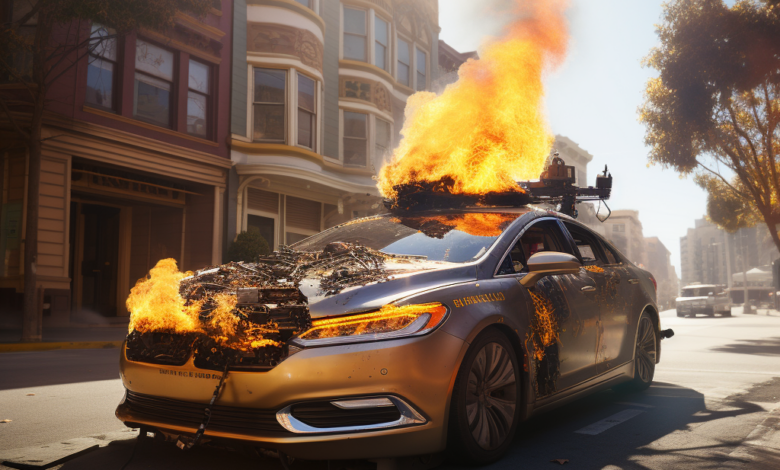
The scene is both exhilarating and surreal, a sight that seemed like a distant dream not long ago. As the cab glides toward me, I can’t help but feel a mix of excitement and uncertainty. It’s a driverless cab, beckoning me to unlock its door using my phone, ready to embark on a journey through the night. Yet, just as I’m about to step in, a passerby’s cautionary words give me pause.
“They’re unsafe”
He warns, recounting an incident where a pedestrian nearly fell victim to a robotaxi.
This individual is part of a growing faction in San Francisco that views the rise of robotaxis with skepticism, even alarm.
To them, the city’s decision to embrace this experiment is nothing short of a dangerous gamble that jeopardizes lives.
And some within this faction are taking action. A campaign group known as Safe Street Rebel has adopted a unique form of protest, using traffic cones to disable robotaxis.
Their efforts have garnered attention and viral videos. However, city officials remain committed to allowing these vehicles to roam the streets, a decision that has sparked impassioned debates.
In August 2023, the California Public Utilities Commission (CPUC) granted two cab companies—Waymo and Cruise—the green light to offer a 24-hour robotaxi service.
Previously, these autonomous vehicles were restricted to nighttime paid rides. However, this decision followed six hours of intense public commentary, a platform where a diverse range of voices voiced their hopes and concerns.
Among these voices were Uber and Lyft drivers who fear the encroachment of robotaxis on their livelihoods.
“Expanding self-driving taxis will take jobs away from families. I’m a single mom,”
lamented Rosine, an Uber driver in the city.
Yet, it’s not just ride-sharing drivers with reservations. Representatives of garbage disposal trucks highlighted how the autonomous vehicles obstruct their operations, a sentiment echoed by San Francisco’s fire service. They claimed to have faced obstruction due to these vehicles on 55 occasions this year alone.
While some argue for the technology’s potential to enhance safety, others remain unconvinced. Cab driver Matthew Sutter raised concerns about the readiness of the technology, asserting that it poses a danger to San Francisco residents.
Disability advocates also joined the conversation, highlighting the challenges that robotaxis pose for those who require assistance to enter cabs. Mara Math, a member of the Paratransit Coordinating Council, expressed concern that embracing robotaxis could exclude disabled individuals.
Yet, supporters of robotaxis also voiced their perspectives. George Janku, an orthopedic surgeon and cyclist in San Francisco, trusts the technology more than unpredictable human drivers. He cited numerous injuries involving human-operated vehicles and affirmed his belief that robotaxis are a safer alternative.
Jessie Wolinsky, who is blind, found comfort in the safety provided by Waymo cars, contrasting it with uncomfortable experiences with Uber and Lyft drivers.
Amid this debate, a mother recounted her experience of being turned down by taxi drivers due to her children’s car seats—a situation that a driverless car would never create.
Having experienced both sides of the argument, I’ve personally ridden in Cruise’s robotaxis multiple times without incident. However, I’ve also been in a robotaxi that broke down in the middle of a street, highlighting the need for refinement.
Only days after the CPUC’s vote, a Cruise robotaxi was involved in a collision with a fire engine. In response, the state Department of Motor Vehicles called for a reduction in the number of robotaxis on the road, a move that Cruise has accepted.
San Francisco’s City Attorney, David Chiu, urged the CPUC to reconsider its decision, asserting that the city would suffer from the expansion of robotaxis. Despite this, Cruise and Waymo stand by their technology’s safety record.
Waymo reported over two million miles of fully autonomous driving with no pedestrian or cyclist accidents. Similarly, Cruise cited a strong safety record with three million driverless miles.
However, skepticism remains prevalent among many San Franciscans. One of the leaders of Safe Street Rebel, speaking on condition of anonymity, sees “coning” as a way to protest the city’s path toward widespread adoption of artificial intelligence. They feel that community-driven actions like theirs are necessary to make their concerns heard.
When asked whether they were akin to the Luddites of the 21st century, a group that resisted technological change in the 19th century, the leader responded, “Yeah, I think there are parallels here. And I think the Luddites get treated unfairly throughout history.”
San Francisco finds itself at a juncture, aspiring to be a hub of innovation yet struggling to carry residents along on this journey. The city’s direction is uncertain, as the car companies assert the safety of their technology. However, winning the trust of San Franciscans remains an uphill battle. The city stands at a crossroads, where technology’s promises intersect with the voices and concerns of its citizens.





